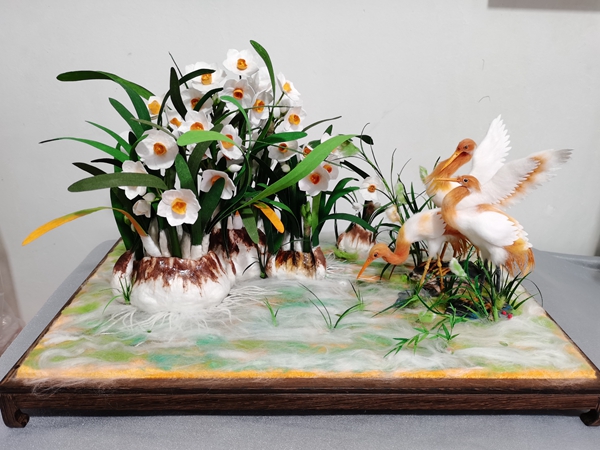

Her artistic expression first appeared in the 1960s in Zhangzhou, producing flowers and characters on quilts with cotton to meet customer demand.
As the quilts couldn't be mass-produced in those days, due to the lack of industrial resources, some of the workers who fluffed cotton to make filling for the quilts, like Huang Jiasheng, began to think of ways to make other items from cotton. They made a bold attempt to separate the two-dimensional pictures on quilts, and applied craft techniques such as binding, molding and pasting to present such exquisite images in glass frames, against a background of non-woven fabric featuring landscape paintings to create the unique arrangements.
"There was a cotton-wadded quilt shop near the entrance of my primary school in 1964," Guo says. "I often dropped in to see how they made things there."
This early exposure to the charm of fiber sculpture led her to sign up for an apprenticeship at the local cotton plant, which was established by Huang. After her middle school graduation in 1971, when she was 19, Guo and other four girls learned to make cotton pictures with Huang.
"We watched him making the cotton pictures, often during lunch hours" she recalls. "None of us dared say anything, we only observed and learned."
Guo has witnessed the prosperity of the trade. In the 1970s and '80s, the demand for fiber sculptures exceeded supply and they were sold to more than 40 countries. China's Ministry of Foreign Affairs used them as gifts for diplomatic occasions. Residents in Zhangzhou were proud of hanging a cotton picture when getting married or moving into a new house.
However, after a while, a growing number of factories started to produce them, which resulted in oversupply and low-quality products flooding the market. In the early 1990s, many factories producing cotton pictures closed.
To make a living, Guo went back home and helped her father maintain the family's photography studio, where she used cotton to make some of the props and backgrounds for photos. She also made cotton pictures from time to time at the studio.
In 2004, local authorities in Zhangzhou approached Guo and asked if she was willing to help revive the craft. "I was torn because I would have to close the studio if I said yes," she says.
She was eventually persuaded to take up the work after she realized the significance of the revival effort. She was especially moved when people from a program on China Central Television reached out to her and told her how many families abroad were interested in the craft.